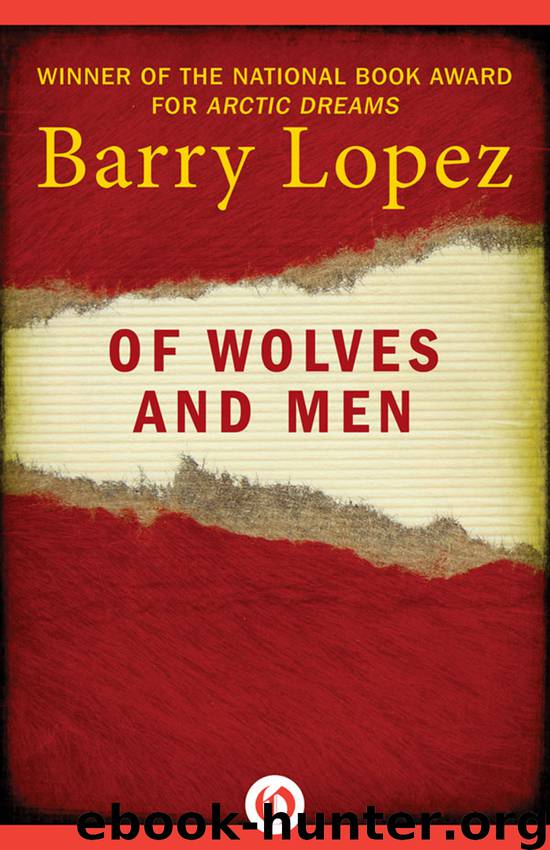Of Wolves and Men by Barry Lopez

Author:Barry Lopez [Lopez, Barry]
Language: eng
Format: epub, azw3
ISBN: 978-1-4804-0915-6
Publisher: Open Road Media
“Moonlight, Wolf” by Frederic Remington.
The prairie expanse of rich grasslands they now faced was a different kind of wilderness for the settlers. De Smet had called it a desert, but farmers whose fathers and grandfathers had cleared the rocky soil of New England and the pine forests of Virginia looked with disbelief at the square miles of open space, dotted here and there with oak groves, and at the richness of the black soil.
The wolf hunted the buffalo herds out here. (Meriwether Lewis had referred to him in his journal as “the shepherd of the buffalo.”) The compulsive attitude of extirpation toward the wolf (but not the fear) eased for a while at the edge of the Great Plains as the pioneers emerged from the dark forests.
Canis lupus nubilus, the Great Plains wolf, was as different from the Eastern timber wolf, perhaps, as woodland Indians like the Delaware were from buffalo Indians like the Sioux, but like the Sioux, he soon came to stand for all his kind. He showed up frequently in the writings of early explorers and pioneers, in ways both good and bad. The greatest attention was paid to the wolf’s howl and then to imaginings about his nature. What to us may seem visions bordering on fantasy were recorded. The German explorer Maximilian of Wied, for example, writes of great white wolves drifting over distant hills one evening with the fireball of the sun setting behind them. Maximilian was unusual in that like many foreign visitors he found the wolf’s howl pleasing and he was “long amused” by the gambols of wolves on the open prairie. He wrote of wolves sitting at the edge of the firelight, “gazing at us without appearing to be at all afraid.”
Out West most people were unnerved by wolves staring at them, and shot at them. A more typical description of the wolf’s howl was this one by James Capen Adams, a self-styled mountaineer and grizzly bear hunter from California: “It is indeed a horrible noise, the most hateful a man alone in the wilderness at night can hear. To a person anywise low-spirited, it suggests the most awful fancies, and it is altogether doleful in the extreme … the lugubrious howl of a pack of wolves is more than I like; and I was glad to put the cowardly rascals to flight by sending a ball after them.”
As for prairie visions of the wolf, few had Maximilian’s appreciation. More common was this buffalo hunter’s description of the wolves: “Each [was] the very incarnation of destruction, with his powerful jaws of shark teeth … and the cunning of man.”
After its howl—it is arresting how often the wolf’s voice is mentioned, as though it were a bell tolling, reminding the traveler of his loneliness in the new land, that he didn’t fit, of Indians, that he was vulnerable—after its howl and stare, it was the wolf’s cowardly nature that was most often mentioned. Wrote one traveler: “Large, gaunt, and fierce as it
Download
This site does not store any files on its server. We only index and link to content provided by other sites. Please contact the content providers to delete copyright contents if any and email us, we'll remove relevant links or contents immediately.
Sapiens: A Brief History of Humankind by Yuval Noah Harari(13112)
The Tidewater Tales by John Barth(12045)
Do No Harm Stories of Life, Death and Brain Surgery by Henry Marsh(6349)
Mastermind: How to Think Like Sherlock Holmes by Maria Konnikova(6271)
The Thirst by Nesbo Jo(5817)
Why We Sleep: Unlocking the Power of Sleep and Dreams by Matthew Walker(5678)
Sapiens by Yuval Noah Harari(4574)
Life 3.0: Being Human in the Age of Artificial Intelligence by Tegmark Max(4536)
The Longevity Diet by Valter Longo(4463)
The Rules Do Not Apply by Ariel Levy(3930)
The Body: A Guide for Occupants by Bill Bryson(3852)
The Immortal Life of Henrietta Lacks by Rebecca Skloot(3840)
Why We Sleep by Matthew Walker(3795)
Animal Frequency by Melissa Alvarez(3770)
Yoga Anatomy by Kaminoff Leslie(3724)
Barron's AP Biology by Goldberg M.S. Deborah T(3643)
The Hacking of the American Mind by Robert H. Lustig(3597)
All Creatures Great and Small by James Herriot(3539)
Yoga Anatomy by Leslie Kaminoff & Amy Matthews(3419)
